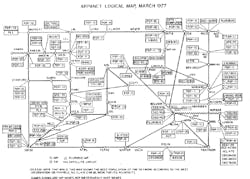In 1989, Tim Berners-Lee, now Sir Tim Berners-Lee, put together the first web server at CERN on a NeXT Computer. Its URL (universal resource locator) was http://info.cern.ch/. The first webpage URL was http://info.cern.ch/hypertext/WWW/TheProject.html.
The likes of Google and YouTube were not even a glimmer at that point. It was known as the World Wide Web (WWW), which is essentially the Internet of today. As with computers, it moved from text to graphics and eventually video, and now virtual reality.
The reason many say the Internet turned 25 this year is that the first public web server was made available in 1991. This fledgling Internet was preceded by the U.S. Department of Defense’s (DoD) ARPANET (Advanced Research Projects Agency Network). TCP/IP came into its own with ARPANET, which started in 1969 with just IMPs (interface message processors). By 1977, the map of the ARPANET fit on a single sheet of paper (Fig. 1).
The rapid rise of the Internet is only matched by improvements in the supporting electronics. The first transistor emerged in 1947 and the integrated circuit (IC) followed in 1959. The first microprocessor, Intel’s 4004, and first microcontroller, Texas Instrument’s TMS1000, popped up in 1971, two years after ARPANET. We now have system-on-chip (SoC) platforms with hundreds of processing cores, FPGAs with multiple high-speed serial interfaces, and server farms linked with optical fiber because copper can no longer keep up with system throughput.
On this 25th anniversary of the Internet, most of us carry massive amounts of computing power and storage in our smartphones compared to IMPs of old. Connected, self-driving cars have yet to move from the lab to the showroom floor, but more than a few universities are working on fine-tuning the technology.
The Internet has changed the way we think about building things, from light bulbs to augmented-reality tools. Pokemon Go uses augmented reality courtesy of smartphones equipped with GPS, turning the phones into gaming platforms that entertain millions.
The Road Ahead
Having lived through all of this, I now get to see the rise of the Internet of Things (IoT) along with everyone else. In less than 25 years, there will be hundreds of billions of IoT devices generating petabytes of data in minutes. That would be inconceivable were it not for the equally inconceivable rise of the Internet. Just remember that hindsight is always 20/20.
The Internet is impressive and marvelous, but with great power comes great responsibility, or irresponsibility. On the whole, the Internet and related tools have had a positive effect. Still, everything from overbearing governments tracking citizens, to criminals using ransomware to demand bitcoins from clueless Internet users, are possible because of the Internet.
Developers had an equally amazing ride with FORTRAN and COBOL, which have given way to C and Java. Even a number of languages, such Javascript, PHP, and Python, are essentially born of the Internet. The rise of the Internet has indirectly made technologies like 3D printing and rapid prototyping of IoT devices practical and second nature.
The Internet as a whole has proven quite robust, but we are all very dependent on a collection of systems that has the potential to collapse like a house of cards if not nurtured properly. The consequences of failure are daunting.
Delta’s recent system failure is an example of what can be wrought by a massive network failure. It grounded an entire fleet of planes, stranding millions of passengers. Luckily, it was only a fraction of the size of the Internet, much of it isolated from the Internet itself, but utilizing the same technology that is part and parcel of the Internet infrastructure (Fig. 2).
It will be interesting to see where the next 25 years takes the Internet and the rest of the world. Technological connectivity and computation are not the only driving factors. In fact, issues like digital rights manager (DRM), ridiculously long copyrights, encryption, hacking, and social media are likely to have greater impact in the future as the Internet becomes an even more integral part of everyday lives.
About the Author
William Wong Blog
Senior Content Director
Bill's latest articles are listed on this author page, William G. Wong.
Bill Wong covers Digital, Embedded, Systems and Software topics at Electronic Design. He writes a number of columns, including Lab Bench and alt.embedded, plus Bill's Workbench hands-on column. Bill is a Georgia Tech alumni with a B.S in Electrical Engineering and a master's degree in computer science for Rutgers, The State University of New Jersey.
He has written a dozen books and was the first Director of PC Labs at PC Magazine. He has worked in the computer and publication industry for almost 40 years and has been with Electronic Design since 2000. He helps run the Mercer Science and Engineering Fair in Mercer County, NJ.
- Check out more articles by Bill Wong on Electronic Design
- Bill Wong on Facebook
- @AltEmbedded on Twitter



